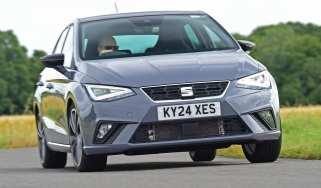Land Rover Discovery 4 review
Versatile Discovery gets mid-life refresh and powerful new diesel engine in an effort to stay at the top of the class.

Styling/Image
A recent facelift has done nothing to disguise the rugged Discovery’s Tonka toy proportions. The nose gets new headlamps and grille, while at the rear you’ll find revised tail-lights. As ever, the big Brit looks just as at home in a farmer’s field as it does outside a posh hotel Buyers get the choice of three trim levels – GS, XS and HSE. Externally there’s little to separate the models, although the entry-level 2.7-litre GS gets 18-inch alloys in place of the 19-inch items on other versions. There’s also the option of a Commercial version that is stripped of its back seats and fitted with darkened rear windows.
Interior/Practicality
With such vast external dimensions it’s no surprise to fine the Disco has a spacious cabin. All versions get seven-seats, all of which will comfortably accommodate adults. The third row folds into the boot floor when not needed, leaving a useful 1,192 carrying capacity. Land Rover’s designers have been at work inside, with a revised dashboard, instruments, switchgear and steering wheel. All models come loaded with standard kit, including climate control, a heated windscreen and air suspension. Range-topping HSE trim adds touch screen sat-nav, a rear-view camera, electric seats and mood lighting.
Engine/Performance
Only two engines are available – the existing 2.7-litre V6 twin turbo diesel and new, more powerful 3.0-litre version. The smaller unit is only available in the entry-level GS and is mated to a six-speed manual gearbox as standard, while all other versions get the larger powerplant and smooth shifting six-ratio automatic transmission. Both the oil-burners major on refinement, though with a massive 600Nm of torque the 3.0-litre engine feels much more eager on the move – the sprint from 0-60mph takes 9.0 seconds.
Driving experience
What is most striking about the Discovery is its supple ride. The combination of air-suspension and a 2.5 ton kerbweight allows the Land Rover to steamroller even the poorest road surfaces. It feels surprisingly agile through corners too, thanks in part to its light controls, commanding driving position and great visibility. However, the big SUV really comes into its own when you hit the rough stuff. With its hi-tech terrain response four-wheel drive transmission, huge ground clearance and torquey engine the Discovery is virtually unstoppable off-road.
Ownership Costs
Even an entry-level Discovery is expensive to buy, while running costs are likely to be equally steep. On the plus side, residuals for all models are over 44 percent, meaning you shouldn’t be in for any nasty surprises when it’s time to trade-in. The new 3.0-litre engine should prove most cost effective to run. Its CO2 emissions of 244g/km and fuel returns of 30.4mpg are significant improvements over the old 2.7-litre automatic gearbox equipped car. Even so, you can expect to pay £405 for an annual tax disc.
Safety/Environment
Eight airbags feature as standard on the Discovery, including curtain items for the third row of seats. Elsewhere you get clever roll and stability control systems. The former throttles back the engine and engages the anti-lock brakes if it senses the car is going to flip over. You’d struggle to call the 3.0-litre V6 eco-friendly, although its CO2 emissions of 240g/km are a 30g/km reduction over the 2.7-litre unit. On top of this, Land Rover runs a carbon offset scheme that covers the first 45,000 miles use of every car it makes.
Our Choice: Discovery XS 3.0TDV6







